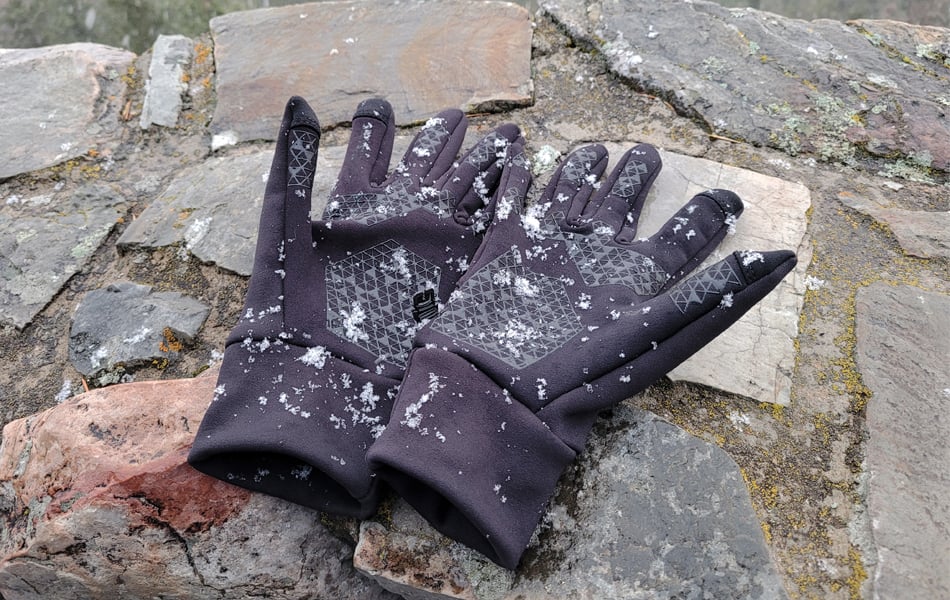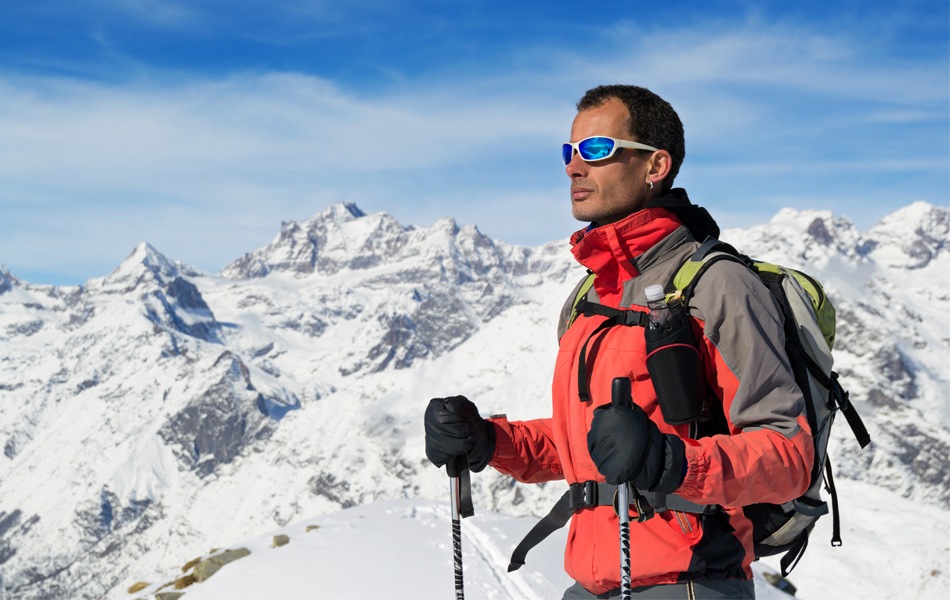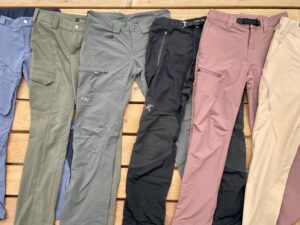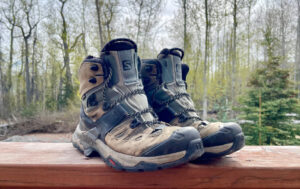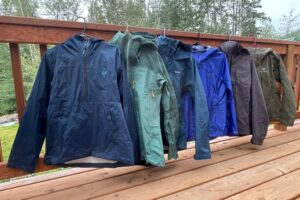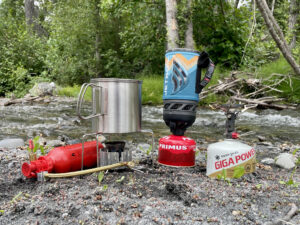Nothing’s worse than cold hands, especially when you are trying to enjoy some nature! That’s why I’ve compiled a list of some of the best hiking gloves on the market. From waterproof soft-shells to minimalist liners, from durable leather to buttery soft merino wool, there’s a bit of everything here, at accessible price points. Hopefully, you find this guide useful.
I’ve personally tested almost all the gloves in this guide, and I’ve done extensive research on the rest. I’m an experienced hiker and backpacker with over 4,000 trail miles to my name and deep knowledge of outdoor apparel technologies, so I know what I like in a hiking glove.
Just remember: what you need in a hiking glove depends on where and how hard you are hiking. Match your glove to your needs, and you’ll be good to go.
Best choice: Hestra Ergo Grip CZone Tactile Short Hiking Gloves

- Highly tactile
- Durable leather construction
- Waterproof-breathable membrane
These gloves are, frankly, the best winter hiking gloves I’ve ever used for moderately cold temperatures. The Hestra Ergo Grip Czone Tactile Short Hiking Gloves live up to their name — I found them to be supremely tactile and grippy gloves, with pre-curved fingers and soft-but-durable leather shells. In my testing, they easily shrugged off water and snow, thanks to a waterproof treatment worked into the leather.
The CZone Tactiles also sports Gore-Tex Infinium backing. This material is highly breathable and windproof, but not waterproof. Thank goodness for the waterproof-breathable lining on the inside of the gloves.
The hook-and-loop cuffs were easy to grab and adjust. As a final touch, Hestra included a stretchy loop that fit around my wrist and allowed the gloves to dangle as I performed navigational tasks on my phone.
The CZone Tactiles aren’t touch-screen compatible, and I wouldn’t want to subject the leather to a total deluge, but for cold, dry climates with occasional bursts of precipitation, these gloves are hard to beat. Read the in-depth review here.
See the Hestra Ergo Grip Glove on Amazon
Warmest: Hestra Fält Guide Hiking Gloves

- Durable all-leather construction
- Removable wool pile-and-terry-cloth lining
- Gauntlet-style with carabiner loop
After a month of testing, I’m happy to say that the Hestra Fält Guide Hiking Gloves became my favorite all-around outdoor gloves. The leather is soft but burly and has stood up to abrasion from snow shovels, icy ski slopes, and trekking poles with nary a scratch. I like the long cuffs with the carabiner loop — great for clipping to a daisy chain when not in use.
But what made these gloves such fantastic all-around competitors is the removable wool-pile lining. I’m a fan of natural materials, and this thick, lofty lining felt great against the skin. But when I wanted something more waterproof, less warm, or more touchscreen compatible, I simply removed the wool lining and paired the Fält Gloves with a different liner. Talk about versatility.
These trekking gloves are an investment but should last a long time with proper care. Read the in-depth review here.
See the Hestra Falt Guide Glove on Backcountry
Most breathable: Arc’teryx Venta Hiking Gloves

- Highly breathable
- Warm enough for high-output activities
- Touchscreen compatible
- Weight: 1.8 ounces
These are some of my favorite gloves for combining high-output hiking with cold and windy conditions. Gore-Tex’s Windstopper fabric is impressive — it cuts the wind and provides just enough insulation to keep me warm when I am working hard. The Arc’teryx Venta Hiking Gloves are touchscreen compatible and feature a brushed inner fabric to provide just a touch of insulation.
The TPU palm reinforcements and the durable Windstopper fabric have held up well against light scrambling and abrasion on firewood, rocks, and trekking poles. The downside to these touchscreen gloves is that heavy rain will zip right through them. Not quite liner gloves, but certainly not waterproof, I usually pair the Ventas with waterproof over-mitts in wet conditions.
See the Arc’teryx Venta Glove on REI
Most comfortable waterproof: Outdoor Research Waterproof Liner Gloves

- Exceptional waterproofness
- Fleece interior
- Rubberized grip for slick conditions
Comfy, warm, and waterproof — Outdoor Research Waterproof Liner Gloves have it all. At a mid-range price point, I’d be most interested in them if I could only afford one pair of hiking gloves and wanted something that could keep my hands dry in wet conditions.
I tested these waterproof hiking gloves in a slushy rain/snow mix at 30 degrees, and they performed admirably. They aren’t as breathable as I wanted them to be, but they are way more breathable than I was expecting them to be. The fleece interior is super-cozy, though, and serves to absorb a little moisture from sweaty hands.
The softshell material seemed rugged enough, though I’d hesitate before doing chores in them. A little bit of grippy rubber across the palms and fingers was a nice touch, as were the large, glove-friendly loops sewn to each wrist-seam. The fit felt a little chunky for liners, which is why I suggest just using these gloves as your primary hand-protection. The screen compatibility was functional if a little clunky due to the thickness of the gloves. For when it gets really cold, choose any of these top heated gloves that won’t let you down, for sure.
See the Outdoor Research Waterproof Liners on Outdoor Research
See the Outdoor Research Waterproof Liners on Amazon
Coolest sun: Outdoor Research ActiveIce Spectrum Sun Hiking Gloves

- Lightweight, snug-fitting sun glove
- Fast-drying and wicking
- Only minimally grippy
- Weight: 0.7 ounces
These fingerless hiking gloves are one of the few in this roundup I haven’t personally tested, though I’m quite familiar with the summer hiking glove (sun glove) category. Additionally, I have extensive experience with Outdoor Research products, including a few other gloves for hikers in this guide. So let’s examine Outdoor Research ActiveIce Spectrum Sun Hiking Gloves with that in mind.
The material is 92% recycled polyester and 8% spandex in a stretch knit, so I imagine they are as breathable, quick-drying, and wicking as Outdoor Research claims they are. The light blue or white color is sure to reflect light well, and the long-gauntlet cut is a nice touch to protect wrists from sun damage. The palm-print anti-slip nubs will help you keep hold of your trekking poles with things that get sweaty, though I’ve seen sun gloves that are more grippy.
See the Outdoor Research ActiveIce Spectrum on Amazon
Most comfortable: Smartwool Merino 150 Hiking Gloves

- Soft and comfortable
- Inexpensive
- Touch-screen compatible
- Weight: 2.47 ounces
If you are looking for minimal hiking gloves that are inexpensive, dexterous, and don’t have to be waterproof, I’ve got a good pair for you. The Merino 150 Hiking Gloves from Smartwool are great for when you need something to cut the chill on cold but sunny days. Bonus points — these lightweight hiking gloves are touchscreen compatible.
I used an earlier iteration of these gloves years ago and found them to be warm enough for below-treeline hiking in shoulder seasons under dry conditions. If I expect precipitation, I usually throw a waterproof shell in my pack to keep these gloves dry. Full disclosure — they aren’t durable, even by liner standards. I’ve worn holes in more than one pair while hiking with trekking poles or scrambling across the rock.
See the Smartwool Merino 150 Glove on Amazon
See the Smartwool Merino 150 Glove on Smartwool
Most versatile liners: Outdoor Research Versaliner Sensor Gloves

- Built-in, stowaway waterproof over-gloves
- Touch-screen compatible
- Soft-shell fabric
Outdoor Research named these gloves Versaliner for a reason. Although they are technically liners (they are softshell material and probably won’t stand up to much abrasion) they come with waterproof shell gloves that stow neatly away at the back of the primary gloves. It’s a cool concept and well executed, and allows any moisture from sweat to collect on the interior of the shell as opposed to inside the liner itself.
The shell storage compartment is also a nifty spot for chemical hand warmers. Outdoor Research Versaliner Sensor Gloves are touch-screen compatible, and I found them less clunky and more responsive on a phone screen than Outdoor Research’s similar (but certainly not identical) waterproof liners.
See the Outdoor Research Versaliner Sensor Gloves on Outdoor Research
See the Outdoor Research Versaliner Sensor Gloves on REI
See the Outdoor Research Versaliner Sensor Gloves on Amazon
Best work crossover: Carhartt Waterproof Insulated Gloves

- The brand is noted for durability
- Grippy nubs on palm and fingers
- Stretch-fleece lining
- Weight: 6.4 ounces
Carhartt has a well-deserved reputation for durability among both outdoor sports enthusiasts and those who earn their living working outside. I haven’t tested these waterproof, insulated work gloves, and they are likely too hot to hike in when the weather is sunny and temperatures are mild. Really, Carhartt Waterproof Insulated Gloves are outdoor work gloves. But for really cold hikes where you need some durability and waterproofness, these gloves will do likely do the trick — and do it at a reasonable price.
I can’t speak to the effectiveness of the waterproofness or how breathable these gloves are, but I’d be willing to bet you can’t rip a hole in them. Sometimes that’s all you need.
See the Carhartt Waterproof Insulated Glove on Carhartt
See the Carhartt Waterproof Insulated Gloves on Amazon
Why trust us
I’m an experienced hiker and backpacker with more than 4,000 trail miles under my feet. I’ve lived and hiked in a range of environmental conditions and used gloves in all of them.
Who this is for
This guide is for people searching for hiking gloves — hand wear that has light insulation is somewhat dexterous, weather-proof, and hard-wearing. You can certainly use some of the gloves in this guide for downhill snow sports, cycling, running, or working outdoors, but be aware that those activities are not what this guide is designed to help you with.
How we picked
For the most part, I included gloves that I’ve tested directly. In some cases, I included gloves that I didn’t test, but come from companies with good reputations and that have produced other products which I own and can vouch for. I picked gloves from a range of price points, from bargains that will last a year or so to investments that will stand the test of time. Finally, I chose gloves for a variety of hiking seasons.
How we tested
It’s important to note that I did not test every glove in this guide. But the ones I did the test, I primarily tested by hiking as that is the subject of this guide. But I also wore the gloves while performing outdoor manual labor, while cross-country and downhill skiing, on walks around my neighborhood, on long runs, while driving, and pretty much any other time you could think to wear a glove. In the case of gloves that claim to be waterproof, I subjected them to light rain and snow.
Features to look for in hiking gloves
Fit
It’s important to get a good fit when choosing a hiking glove. Too tight and you’ll cut off circulation — and warmth. Too loose and you won’t have the dexterity you need to accomplish even basic tasks. Make sure you check sizing instructions on the manufacturer’s website before you make a purchase. Each glove maker sizes their gloves slightly differently, so a medium with one brand might be large in another.
Warmth
How warm of a glove do you need? This depends on how cold your hands usually get, how hard you are working as you are hiking, and what the weather is like. The main thing to remember is that highly insulated gloves (such as ski gloves) make poor hiking gloves. Hiking gloves should have insulation enough to keep you warm while you are in motion. Otherwise, your hands will get sweaty, and that will actually make your hands colder than less-insulated gloves would have.
Shell
The shell refers to the outside of a glove. Shells come in leather, polyester, cotton, wool, spandex, lycra, neoprene, and blends of all the above, plus more. Performance fabric companies such as Gore-Tex make highly technical shell-fabrics that excel at wind protection, water protection, and so on. Your needs (windproof, breathable, waterproof, etc.) should determine your choice of shell material.
Insulation
Insulation refers to the material inside the glove that traps air. That air heats up by the warmth of your hand. The more insulation a glove has, the warmer it will be — and also the bulkier. Insulation sources range from natural materials such as wool to synthetic materials such as polyester. Many outdoor brands have proprietary forms of insulation.
Breathability
If you are working hard, generating a lot of heat, and only need a glove to block the biting effects of the wind, you might consider purchasing a glove with high breathability. Highly insulated gloves often have less breathability, though this isn’t a hard and fast rule. Many glove manufacturers consider breathability more important than waterproofness. Highly breathable gloves are sometimes made of expensive, technologically advanced fabrics.
Lining
The lining of the glove is the material on the inside of the glove that touches your skin. Lining can be as simple as woven polyester or piled wool. It can also be complex, like the waterproof-breathable membrane found in our Best Choice Glove. The lining should feel comfortable and grip your hand without being too tight — after all, it’s the layer closest to you!
Layering
Many hikers choose a layering system comprised of an outer glove and an inner (or liner) glove. Outer gloves tend to feature sturdy material, while liner gloves, while dexterous, often won’t stand up very well to abrasion. Sometimes hikers add another layer — a waterproof shell or over-mitt. If you are going to use a layering system while gloving it up, make sure your size accordingly, especially for the outer glove.
Waterproofness
Waterproofness is a tricky subject because things that are absolutely, truly waterproof gloves for hiking are also usually non-air permeable. Have you ever worn a rubber kitchen glove hiking? Your hands will get super-sweaty in there. That’s why glove manufacturers use materials that breathe better but are also not 100% waterproof. Even fancy, expensive waterproof-breathable materials will wet-out after extended and heavy precipitation. That being said, some gloves perform better than others, and we’ll be sure to highlight the top performers as we walk you through our chosen products!
Hiking gloves FAQ
Q: What are hiking gloves?
A: I’ll be honest. You can use just about any gloves for hiking. But I’ve found the best hiking gloves to be comfortable (i.e., not unlined leather like leather work gloves), warm, and somewhat breathable. Waterproofness is a bonus but not a necessity depending on climate and regular hiking needs. Highly tactile gloves (gloves that allow you the dexterity to perform delicate tasks) are also desirable.
Q: What level of protection do I need?
A: This depends on how often you hike, where you hike, the type of hiking you are doing, and the other gear you have. Many hikers choose to use waterproof over-mitts so that they don’t have to bother with waterproof gloves, which tend to be bulky or over-warm. Some outdoor performance fabrics excel at wind protection but are not waterproof, and so are best used in cold but dry climates.
So the best way to answer this question is to do some thinking about your use-cases, and then find a glove with the specifications that match your needs.
Q: Should I choose mittens or gloves for hiking?
A: The answer to this question depends on how cold your hands get and how much dexterity you’ll need while hiking. Mittens are warmer because they create a pocket of air that your hands can fill with heat. They also allow you to wiggle your fingers around more, promoting blood flow — and thus warmth.
Gloves are slightly cooler than hiking mittens (in general) but obviously aren’t as tactile. So if you feel like you’ll be fiddling with navigational tools, pack straps, or cameras a lot while hiking, opt for a glove.
Q: Glove sizing – How can I get a good fit?
A: Once you choose a glove, it’s crucial that you find the brand’s sizing information before making a purchase. Each brand is slightly different. It’s also useful to read reviews, as many users often provide feedback about if sizing runs true or not. A cloth tape measure is often useful for getting accurate hand measurements.
Q: How can I wash my hiking gloves?
A: Follow the manufacturer’s instructions. Some of the cloth liner gloves in this guide are fully washable, while gloves made of leather or technical materials need to be spot cleaned.
Sources:
- Merino – Wikipedia

